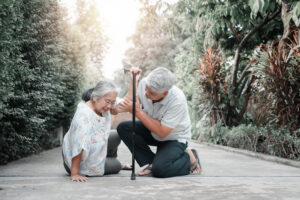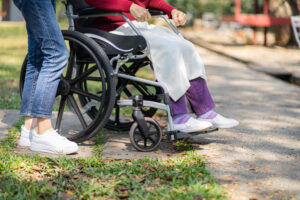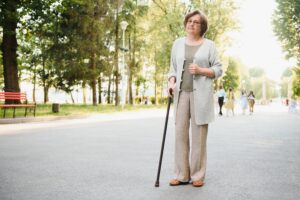Elderly fall is the leading cause of death, injury, and hospital admissions among the geriatric population. According to the Centers for Disease Control and Prevention (CDC), one out of every four Americans aged 65 and older falls each year.
Seniors are not only more likely to fall, but they are also more vulnerable to harm. More than 8 million of the almost 36 million senior individuals who fall each year suffer injuries resulting from the accident, such as a broken hip or head trauma. Understanding why older people are more vulnerable can assist family caregivers in taking the necessary steps to keep their loved ones safe on their feet.
Contents
Reasons Why Elderly Fall Happens

A variety of circumstances might cause an elderly fall. Keep in mind that one or more of the following risk factors are typical in older persons.
Declines in Physical Fitness
As people become older, they become less active, which exacerbates the physical impacts of aging. Diminished muscle mass and strength (sarcopenia), decreased bone mass, poor balance, and coordination, and reduced flexibility are all consequences of failing to participate in even basic exercise regularly. Not only does general deconditioning raise the risk of an elderly fall, but it also increases their chances of suffering a catastrophic injury and having to recover more slowly and painfully.
Impaired Vision
Elderly fall risks such as steps, puddles, and thresholds are difficult, if not impossible, to recognize due to age-related eye disorders. Even if a senior is in excellent physical shape, failure to observe and correctly interpret impediments or changes in ground level might result in a dangerous fall. Refusing to follow doctor’s treatment advice, such as wearing eyeglasses and utilizing appropriate low vision equipment, can also lead to elderly falls.
Medication Side Effects
A wide range of drugs increases elderly fall risk. Drowsiness, dizziness, and low blood pressure are all side symptoms that might lead to an accident. The most prevalent causes include sedatives, antidepressants, antipsychotics, opioids, and several cardiovascular medicines. According to a study on polypharmacy in older individuals, 39% of this age group takes five or more prescription drugs. Polypharmacy raises the risk of adverse drug responses and falls caused by medications. Remember that OTC drugs and dietary supplements might have significant adverse and synergistic effects.
Chronic Diseases
Elderly falls can also be caused by Parkinson’s disease, Alzheimer’s disease, and arthritis, which compromise balance, physical strength, joint integrity, or cognitive function. A person’s capacity to respond to dangers and recover from mishaps, such as tripping or slipping, is harmed by poor physical condition. Numbness in the feet can be caused by peripheral neuropathy or nerve damage. It can make it harder for a senior to detect environmental risks and navigate safely.
Surgical Procedures
Hip replacements and other surgery can leave an aging person frail, in pain, and less mobile than before. This might be a temporary issue as a patient heals, or it could develop into a new and long-term problem. Geriatric rehabilitation is critical in assisting older persons to regain as much physical, cognitive, and functional abilities as feasible.
Environmental Hazards
The majority of elderly falls happen in or around older citizens’ homes. Poor lighting, clutter, deterioration, loose carpets, slick flooring, and a lack of safety equipment (e.g., grab bars, ramps, elevators) can all jeopardize a senior’s safety. In many situations, dangerous living conditions result in accidents and falls, making it impossible for older people to age in place.
Behavioral Hazards
The lifestyle and activities of an individual impact their risk of an elderly fall. It covers the sorts of activities people participate in, the degree of physical effort these activities impose, and their desire and capacity to change their routine to improve their safety. Wash, for example, is a typical daily task for many individuals. Still, it can be strenuous for seniors, especially if they have to carry a big laundry basket around their house.
It is dangerous enough on its own. But they put themselves in much more danger if they refuse to wear sturdy, non-skid footwear or attempt to climb stairs with the basket. Failure to adjust behaviors in response to new or growing challenges is a critical but all-too-common cause of an elderly fall.
Things to Do When an Elderly Fall Happen

When an elderly fall happens, the first and most important measure is staying cool and not panicking. You are their initial point of contact, and you don’t want to be unable to assist them efficiently. After that, analyze the situation and look for any injuries, particularly in the head area. Inquire about any discomfort they’re having and where it’s coming from.
If they want to get up, you can assist them in gently rising off the floor if there is no evidence of shattered bones or other significant injuries. Assist your loved ones by ensuring that they have access to assistive gadgets or sturdy furniture, such as a chair or a grab bar, to prop themselves up. Stop if your loved one becomes trapped, in pain, or too exhausted to make it up.
It’s important to remember that you shouldn’t be raising your weight. While you hold them stable, your loved ones should be able to stand up on their own. Call an ambulance if they are unable to stand. If you’re unsure what to do or help an older person up from the floor, it’s better to contact an ambulance immediately.
Ways to Prevent an Elderly Fall

Senior woman walking in the park in summer.
Keep Moving and Stay Active
Elderly fall prevention can be as simple as exercising daily. By strengthening your strength, balance, flexibility, and coordination, gentle exercises and light activities such as walking, water workouts, and fundamental strength and balance exercises can significantly lower your chance of falling. If you’re not sure what activities are ideal for your senior loved ones, talk to a doctor or physiotherapist about it. They can provide you with advice based on your loved one’s specific needs.
Keep Your Bones Strong
Your bones have a propensity to shatter more readily if they are weak. You can build your bones and maintain them healthy every day by increasing your calcium intake and taking vitamins or supplements. Milk, cheese, and sardines are examples of calcium-rich foods. Vitamin D is also important for bone health because it absorbs calcium from our food. Foods like eggs and fatty seafood like tuna and salmon include this. You may also opt to add cod liver oil vitamins to your diet. It can help to enhance general bone health and minimize joint discomfort.
Go for Regular Eye Checkups
Adults aged 18 to 60 are encouraged to get regular eye checks and examinations every two years to preserve healthy eyesight as they age. “At-risk” individuals and seniors should schedule more appointments. Older adults aged 61 and up should get annual physical checkups and nothing less. It allows your doctor to update your prescription if it has become obsolete. They can also identify whether you have any eye disorders that might impair your vision and raise your risk of an elderly fall.
Always Stand Up Slowly
Most people feel a sensation known as a head rush when they rise from a sitting or lying posture. A dip in blood pressure causes you to feel lightheaded and unstable for a short time. Please make it a habit to carefully rise from your prior posture and take a few moments to gather your bearings before proceeding when moving and walking much longer distances. Walking aids such as canes and walkers can give you the support you require.
Monitor Your Medications
Antidepressants and Hypno-sedative medications can impair your balance and coordination. Also, it produces dizziness and drowsiness, raising your risk of falling. Falls in elderly individuals have been connected to drug and prescription implications in research conducted by Therapeutic Advances in Drug Safety. If you use a lot of medications, you’ll almost certainly become more prone to falling. Consult your doctor about your current medications. Also, you can ask if you might be prescribed different ones instead to help you avoid an elderly fall.
Wear Proper Non-Slip Footwear
For an elderly fall, backless, heeled, and loose-fitting shoes are a substantial risk factor. This issue, however, may be readily resolved. The National Institute on Aging suggests wearing non-skid footwear with rubber soles and low heels. These shoes offer more grip and friction, which might help you avoid slips and falls. At the same time, avoid walking on freshly cleaned floors because they may be pretty slippery.
Light Up Your Living Space
Did you know that one of the most common causes of an elderly fall is environmental factors such as poor lighting in their homes? According to a study published in the Journal of Physical Therapy Science, “inadequate information owing to low illumination might increase the risk of falling due to undetected impediments or decreased bodily stability poor everyday life.” In addition, if you live with an older adult, make sure your home is well-lit.
Remove Excess Furniture
Clear routes in your area by eliminating extra furniture, providing an environmental danger to seniors attempting to navigate their homes. Keep cables and loose cords off the floor, clean spills immediately to dry the area, and install non-slip mats on bathroom floors to prevent sliding. These are just a few examples of simple home adjustments you may make to your space. Other minor changes in the bedroom include having a night light, an emergency flashlight, and a phone near the bed.
Install Assistive Devices
If you are staying with a senior, employing assistive equipment should be included in the list of house adjustments. Handrails for stairwells, grab bars for various sections in the bathroom, and higher toilet seats with armrests. these are examples of assistive equipment to consider adding. It helps elders maintain their independence and carry out their everyday tasks with ease. You may also shop for and buy a range of assistive gadgets on the internet.
Visit a Specialist for Elderly Fall
Many people are unaware that specialists specialize in the treatment of older individuals who fall. The process usually starts with a geriatrician consultation. then followed by a physiotherapy evaluation of your muscular strength, balance, walking, and posture. After that, you’ll get a quick checkup with a nurse to check your blood pressure, eyesight, and memory. Finally, the nurse will go through any previous falls you’ve had and teach you how to avoid them.
Conclusion
Elderly fall prevention is better than cure. Falls may have significant repercussions for elders, including the inability to walk, costly procedures, and even a loss of independence. Falling is not a natural part of life, but aging is. Don’t allow falls to stop you from staying active and safe. Make sure you have the tools and knowledge you need.
While elderly fall prevention does go a long way, it is unavoidable that some elders may fall at some time. If this happens to you or a family member, make an appointment with your doctor to assess the severity and impact of the fall so that they can receive the care they require. After a fall, a senior’s mobility may be reduced, making it difficult to go to and from medical appointments or even complete regular chores at home.
In such cases, home care may be a practical choice that assists elders with everyday tasks and helps them rebuild strength, relieve discomfort, and heal from any injuries acquired as a result of the fall. In-home care also has the added benefit of allowing professional caregivers to analyze your home environment. It can identify possible elderly fall hazards, and advise you on home changes that you can make, which is essential in elderly fall prevention because most falls happen at home.
Read More:





